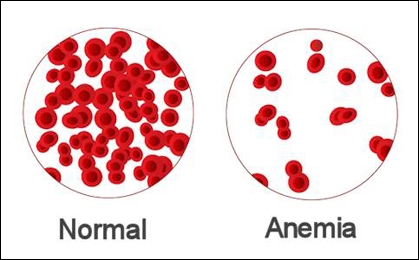Anemia - symptoms, causes, diagnosis & treatment
What is anemia?
Anemia is a condition where RBC count is decreased in the blood. In a normal blood test anemia is reported as low haemoglobin or hematocrit (the ratio of the volume of red blood cells to the total volume of blood). Haemoglobin helps in carrying oxygen to various parts of the body, by the deficiency of haemoglobin there would be deprived supply of oxygen to various parts of the body, that would lead to certain symptoms as mentioned below.
Symptoms
In the mild condition of disease one could not notice the symptoms but they may affect after severe conditions. symptoms generally include:
Dizziness,
lightheadedness,
Fast or unusual heartbeat
Headache
Pain, including in your bones, chest, belly, and joints
Growth problems for children and teens
Shortness of breath
Skin that’s pale or yellow
Cold hands and feet
Tiredness or weakness
Types & causes
There are around 400 types of anaemia categorized into 3 groups
By blood loss
By decreased or faulty RBC production
By destruction of RBC
Anemia Caused by blood loss:
Causes of anaemia by this group mainly include some of these conditions:
Gastrointestinal diseases such as ulcers, hemorrhoids,
gastritis (inflammation of stomach), and cancer
Non-steroidal anti-inflammatory drugs (NSAIDs) such as aspirin or ibuprofen, which causes ulcers and gastritis
Too much bleeding during periods in women
Post-trauma or post-surgery
Anemia Caused by decreased or faulty RBC production:
Bone marrow is the soft and plays the essential role in the production of rbcs, and produces stem cells, which develop into RBCs, white blood cells, and platelets.
Sickle cell anemia
Iron-deficiency anemia
Vitamin-deficiency anemia
Anemia Caused by destruction of RBC:
Hemolytic anemia occurs during the destruction of rbc, they become fragile and can't handle stress, while traveling through the body. Sometimes this hemolytic condition is unclear and can include following conditions:
Toxins from advanced liver or kidney disease
Enlarged spleen
Other conditions such as sickle cell anemia, thalassemia, and thrombotic thrombocytopenic purpura (TTP)
Infections, drugs, snake or spider venom, or certain foods that cause strain in the body.
Vascular grafts, prosthetic heart valves, tumors
Severe burns, being around certain chemicals,
Severe hypertension, and clotting disorders
Others factors that causes anemia includes:-
Bone marrow and stem cell problems
Iron deficiency anemia
Vitamin - deficiency anemia
Sickle cell anemia
Diagnosis
Most common diagnosis tests used to understand the haemoglobin levels is CBC - complete blood count.
Sometimes it is made necessary to study a sample of bone marrow to diagnose anemia, this test is called Colonoscopy.
Treatment
In most of the cases treatment depends on causes of anaemia.
Iron supplements are recommended if the anemia is caused by blood loss.
Vitamin B13 deficiency anemia is prescribed with supplements.
Aplastic anemia needs medications, blood transfusions or a bone marrow transplant.
Anemia associated with bone marrow disease is treated by bone marrow transplant or stem cells transplant or blood transfusion.
Hemolytic anemia need medication that will hold back your immune system.
Sickle cell anemia is treated oxygen therapy, blood transfusions and Autosplenectomy.
Thalassemia needs treatment only with severe conditions that may include oral pills, menorrhagia, blood transfusions or a bone marrow transplant or surgery.






